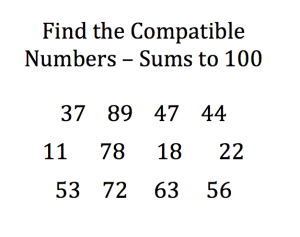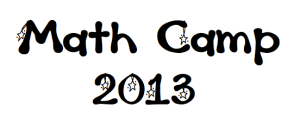First, let me say what a wonderful year of collaboration it has been with the teachers from Alwin Holland Elementary School. Thank you, ladies, for your hard work in mathematics this year. We all came away having more informed than we were about mathematics education.
Part of our last day together was spent in two different classroom where I did demonstration lessons. In the grade one classroom I demonstrated the teaching of the +9 addition strategy (as learned in the basic facts addition blog) using 10-frames.
In the grade 2/3 split classroom, the teacher was interested in a fraction lesson that centered around problem solving.
I started the lesson by talking about a class which was made up of 1/2 boys. I asked the children if they thought the class had only two students in it, one of which was a boy. They all agreed that, no, the class was larger than two, and they offered suggestions of how many might be in the class, and then how many of them would be boys. At one point I asked if they thought 23 might work for the class number, and they knew that being an odd number, it did not work to divide the class in half. I then presented this question that I had written for the lesson:
Marcie grabbed some bingo chips from a bag on the table. After sorting her chips, she told her friend that 1/3 (one-third) of them were red. What might her chips have looked like? Find as many different solutions as you can. Each solution should use a different number of chips altogether.
The students had bags of bingo chips to share in their table groups, and they used the chips to find a variety of solutions. All of the children were able to come up with some solutions, and a few of them realized they could keep adding one more chip to each of their sets to find more answers.
When we shared our solutions I put the information on a T-chart with one side labeled “number of red chips” and the other “total number of chips”. Students gave their answers in random order, and after we had quite a list, I suggested we look for a pattern. I made a new T-chart with the same headings, but we listed our answers in order of number of red chips: 1, 2, 3.. No one had given an solution with 7 red chips, but it was easily figured out by looking at the pattern that presented itself. The students recognized the pattern in the second column was “skip counting by threes”. Then I proposed some big numbers of red chips such as 20, 100, 1000 and they could answer the total number of chips to be 60, 300, and 3000 respectively. Finally we looked for the “n-rule”: for n number of red chips, how many chips altogether. At first students guessed other large numbers (500, a million, etc.), but finally one boy said “It would be n + n + n.”
It was the first look at the n-rule for the students, but the teachers were motivated to go back to some other patterns and play with that idea with children. Anytime we help kids move to that point, we are laying the foundation for algebraic thinking.
All in all it was a fabulous day! Thanks again to the collaboration group from Alwin Holland School!
Mathematically yours,
Carollee
 It was wonderful to share the Friday morning session at the Calgary City Teachers’ Conference with so many new friends! I hope you walked away with some ideas for helping your students understand mathematics is a deeper way. Congratulations to Shannon Muir who won the math coaching session in the draw!
It was wonderful to share the Friday morning session at the Calgary City Teachers’ Conference with so many new friends! I hope you walked away with some ideas for helping your students understand mathematics is a deeper way. Congratulations to Shannon Muir who won the math coaching session in the draw!








